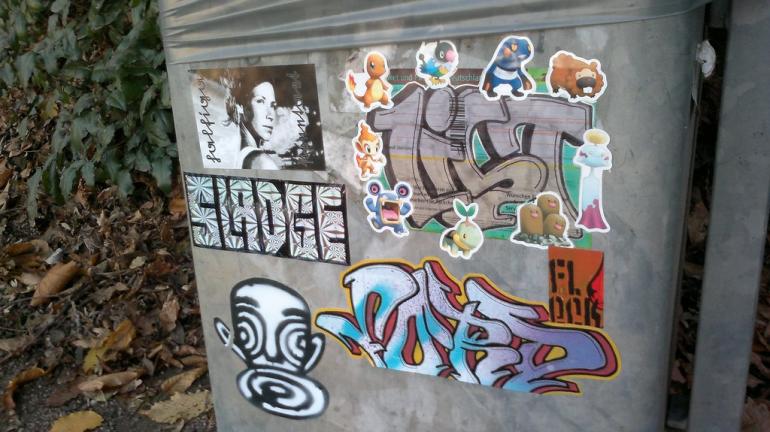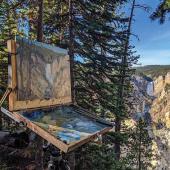Writing on the Wall
Taking a look at downtown Bozeman's graffiti scene.
Bozeman. It’s definitely not a jungle out there. Nor is it particularly urban. But thankfully it’s not just empty landscapes and cows either. Sprayed on various walls and dumpsters, furrowed in the deep grime of windows, and marked on pale green and grey electrical boxes are the clear (yet not always legible) impressions of graffiti. Talking to a prominent, downtown business owner about graffiti recently, I was intrigued to hear that she wasn’t necessarily opposed to the emergence of street art. She also told me that MSU film students often turn to Bozeman’s alleys, brick-walled and latticed with fire escapes, when they need a metro feel for their films. And as I skulked my way down these byways at night, tripping motion sensor security lights and panning my little flashlight around, I began to understand the attraction.
Of course, when it comes to deciphering “wild-style” tags and understanding the rules of graffiti, it helps to have a guide. For this I turned to Motiv (short for MOTIVONE as any alley dweller will know), Aeris (AERISONE), and Gamin (GAMIN), three local graffiti artists and fairly inseparable friends who range in age from 17 to 21 and work together as Speech Crew—a name referring to their essential interest in the nature, quality, and power of words and images. It’s an apt designation for these three as they are well-acquainted with the language and history of graffiti, and are prone to speaking about it passionately. And this type of accelerated alleyway pedantry is most certainly relevant to the artistic nature of graffiti. In other words, be prepared, be fast, but for fuck’s sake, be eloquent.
Is graffiti art? “Absolutely!” says Motiv. When asked to elaborate, she doesn’t even have to think: “It’s the amount of preparation that goes into a ‘piece.’ You don’t just go out there with a can of spray paint. You sit down and think about what you’re doing, and you put it together, and you sketch it out, and you perfect it. And then when you feel you’re ready, you go out and you put it up.” On personal artistic development, Aeris states, “Wherever I am at a point in time, I don’t like being there, because I’m always working toward the next step that I want to be at.” Motiv adds a general rule for herself and others on the graffiti scene: “You suck until further notice.”
This is an important rule. Bozeman is a small town, and since the sub-cultural (not to mention legal) rules dictate that personal property, places of worship, federally protected buildings, and historical sites are excluded from artists’ marks, the space and opportunity for their pieces (short for masterpieces) and “throw-ups” is relatively limited. Tagging (an author’s name, generally written with marker or paint in a compositionally challenging manner) is a way to practice skills while focusing on location and placement. But while Gamin acknowledges that one has to start somewhere “and it may just be your name written with a marker,” he and the others acutely stress the significance of working in their black-books at home prior to making any public marks. “Something that people don’t realize is that there are graffiti artists and then there are people who don’t get it,” Aeris says. “I know that all three of us have put hours and hours and hours into our black-books before we even consider going out with a can.”
This is good advice not only for would-be taggers, but for artists everywhere. Stand in front of the sanctioned Haufbrau piece, or approach the wall by the interstate overpass on North Rouse, and you will understand the transformation that takes place from crappy tags to well-considered throw-ups, with a lot of practice in between. These pieces exist as instigation and stimulation for other artists and viewers—which, beyond personal glory for the artist, seems to be the role of graffiti.
All art comes with a price; whether that price is emotional, psychic, or civic shouldn’t necessarily be the focus or concern of the encounter. The gray area of graffiti is that the viewer is usually taken off-guard, and reliance on expectation becomes challenged. A wall that has been blank for many years is suddenly tagged with a name or character, thus creating an affront to the process-oriented, democratic notion of civic responsibility. But it should be remembered that one of the fundamental roles of art is giving voice to individuals trying to translate their experiences to the group. Venues are as varied as the artists themselves. Graffiti’s bold (and usually, illegal) gesture, which society tends to condemn and label anti-social, at the very least forces a new relationship to occur between the public and the personal. As Motiv says, “It’s one of those objectionable arts where people either love it or hate it.” And in the fairly homogenous Bozone, where group dissent is somewhat less than ubiquitous, at least we are compelled to confront it













